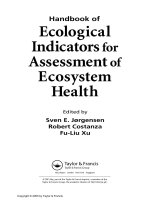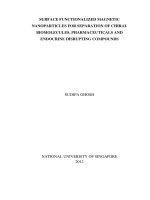Novel biodegradable cationic core shell nanoparticles for codelivery of drug and DNA 1
Bạn đang xem bản rút gọn của tài liệu. Xem và tải ngay bản đầy đủ của tài liệu tại đây (30.46 KB, 5 trang )
1
Chapter 1
Introduction
Gene therapy refers to the transmission of DNA encoding a therapeutic gene of interest
into the targeted cells or organs with consequent temporary or “permanent” expression of
the transgene. The purpose of delivering transgene into the targeted cells or organs is to
treat the disease caused by genetic disorders, mutation or genetic defects such as
leukemia and tumors. Recently gene therapy has received increasing attention from the
scientific society. However, the Food and Drug Administration (FDA) has not yet
approved any human gene therapy product for clinical applications. Current gene therapy
is experimental and has not proven very successful in clinical trials. Little progress has
been made since the first gene therapy clinical trial began in 1990. This is because there
are very few safe and efficient gene carriers available. There are three kinds of gene
delivery vectors, including bacterial vector, viral vector and non-viral vector. The process
of using bacteria as the vectors to carry gene into cells or tissues and express in the cells
is called bactofection [Pilgrim S. et al, 2003] while the same processes of using virus and
non-viral vectors are called infection [Lundstrom K., 2003] and transfection [Niidome T.
and Huang L. et al, 2002] respectively. Bacteria are seldom used as the gene vectors
because of their innate ability to induce serious immune response, such as septic shock,
and the limitation of sites for bacteria to target on delivery of genes [Luo D. et al, 2000;
Pawelek J. M. et al, 2003]. Compared with bacterial vectors, viral vectors have higher
2
gene delivery efficiency and gene expression level [Lundstrom K., 2003] but their
toxicity and immunogenicity limit their application. They also have other problems such
as the restricted targeting of specific cell types, limited carrying capacity of DNA and
complicated production and packaging procedure [Luo D. et al, 2000]. Non-viral vectors,
especially cationic lipids vectors and cationic polymeric vectors may help to solve these
problems.
Cationic polymers and lipids are by far the most widely used non-viral vectors. They
carry genes by combining DNA through static interaction between the cationic lipids or
polymers and DNA. For cationic lipid [Pedroso de Lima M.C. et al, 2001], their
versatility is limited compared to that of cationic polymers. Therefore most research
efforts have been focused on cationic polymers. The frequently used cationic polymers
for non-viral gene delivery include polyethylenimine (PEI), poly(L-lysine), imidazole
containing polymers, chitosan, polyamidoamine (PAMAM) dendrimers and their
derivatives [Merdan T. et al, 2002]. These cationic polymer vectors usually have high in
vitro gene expression (in cells), but in vivo gene expression (in animals) has been much
lower than expected, especially compared with that of viral vectors, although their
immune response has been lower than that of viral vectors. Furthermore, the toxicity of
these cationic polymers has shown the tendency to increase with the increase of gene
transfection [Luo D. et al, 2000]. Therefore, a great number of other cationic polymers
that do not fall into these species mentioned above have also been synthesized [Wang J.
et al, 2002]. Unfortunately, little improvement was made. Studies have shown that the
reasons of low in vivo gene transfection and high toxicity of these cationic polymers are
complicated [Merdan T. et al, 2002; Tang M.X. et al, 1997]. In addition, the surface
3
charges of the complexes may lead to absorption of proteins in the blood onto the
complexes, rendering the disruption of DNA/cationic polymer complexes. Furthermore,
the complexes themselves may not be stable enough in the blood. Studies have shown
that they tended to aggregate or dissociate in a short time [Tang M.X. et al, 1997].
Therefore, poly(ethylene glycol) (PEG), a hydrophilic biocompatible polymer, which is
often used as the hydrophilic block of polymeric micelles, has been introduced to cationic
polymers [Tang M.X. et al, 1997; Smrekar B. et al, 2003; Dash P. R. et al, 1997 ] to
protect the complexes from absorbing proteins and improve their stability. The
introduction of PEG or other hydrophilic polymers into the cationic polymers actually
makes them amphiphilic, which can self-assemble into micelle-like core shell structure in
aqueous media. However, although introduction of PEG onto cationic polymers prevents
the interaction of the complexes with ingredients in the blood, pegylated cationic
polymers often have weak DNA binding ability because of steric hindrance of PEG
shield. In addition, it was reported that the pegylation of cationic polymers usually led to
lower gene transfection efficiency [Lee H. et. al., 2002; Itaka K. et. al., 2003].
Furthermore, although some non-viral vectors exhibit many advantages such as minimal
host immune response, possession of targeting ability and ease of production in large
quantities, gene transfection efficiency is low. A number of approaches have been
proposed to enhance gene expression, including the codelivery of chloroquine [Zhang
X.H et al, 2001], imidazole [Pack D.W., et al, 2000] or inactivated adenovirus [Cotton M.
et al, 1992] with polymer/DNA complexes. In these formulations, the drug and gene were
administered by separate injections. However, in order to achieve synergistic effect of
drug and gene therapies, both the drug and gene have to be delivered to the same cell type.
4
Therefore, there is a great need to develop a delivery system that can carry both the drug
and gene simultaneously.
Therefore, the main objectives of this study are to design and synthesize a series of
cationic amphiphilic polymer, which can self-assemble into cationic polymer micelles
[Figure 1.1]. The polymer is composed of pendant chains and a main chain. The pendant
chain is a derivative of cholesterol that is a naturally produced hydrophobic compound,
and the main chain is polyester, which carries tertiary amine and quaternary ammonium,
and is assumed to be degradable by hydrolysis. The micelles self-assembled from this
polymer possess a hydrophobic core for encapsulation of drug molecules and a positively
charged shell for DNA binding. By using this system, codelivery of DNA and drug can
be achieved. In addition, due to the unique core-shell structure, it is expected that the
stability of the micelle/DNA complexes can therefore be greatly enhanced when
compared to conventionally-used water-soluble cationic polymers.
Specifically, the studies to be conducted include,
• Synthesizing a series of degradable cationic amphiphilic polymers and utilizing
these polymers to fabricate cationic core-shell nanoparticles (i.e. micelles) for co-
delivery of drugs and genes,
• Pegylating the amphiphilic polymers using PEG of various molecular weights,
• Studying size and size distribution as well as stability of the nanoparticles under
various conditions simulating storage, micelle fabrication and physiological
environment,
5
• Evaluating DNA binding ability of the blank and drug-loaded core-shell
nanoparticles, and structural integrity of core-shell nanoparticles during the DNA
binding process,
• Testing cytotoxicity of the core-shell nanoparticles and examining their in vitro
and in vivo gene transfection efficiency,
• Investigating the effect of core-shell structure on the gene transfection efficiency
of the nanoparticles,
• Studying the in vitro and in vivo synergistic effect of drug and gene delivery using
different model drugs.
In the following chapters, literature will be systematically reviewed. Materials and
experimental methods employed in this study will be introduced, followed by results
and discussion, conclusion and recommendation for future work, and references.
Figure 1.1 Schematic drawing of the cationic micelles (hydrophobic drug molecules are
loaded in the core and DNA are bond on the surface.), and molecular structure of the
polymer
NH
O
H
H
H
O
CH
3
CH
3
H
3
C
H
3
C
H
3
C
O
C
O
C
O
q
(CH
2
)
n
(CH
2
)
2
(CH
2
)
2
CH
3
N
O
O
C
(CH2)
n
+
Br
CH
3
NH
O
C
O
p
(CH
2
)
2
(CH
2
)
2
NO









